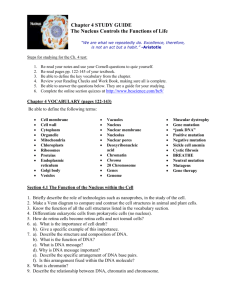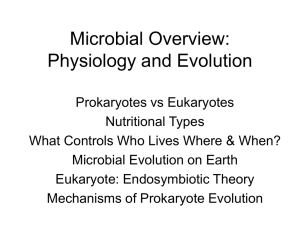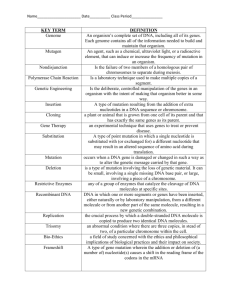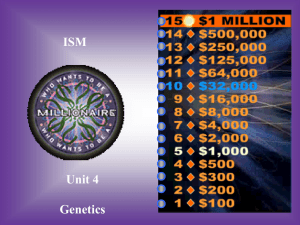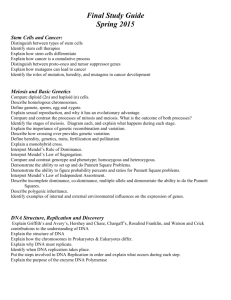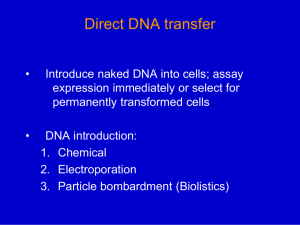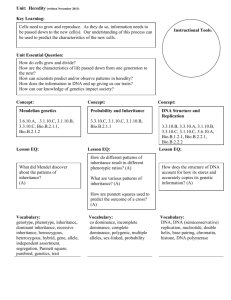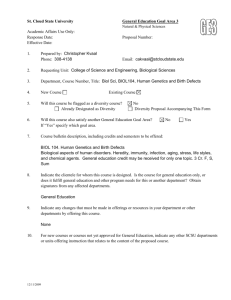AP Biology * Ms. Whipple
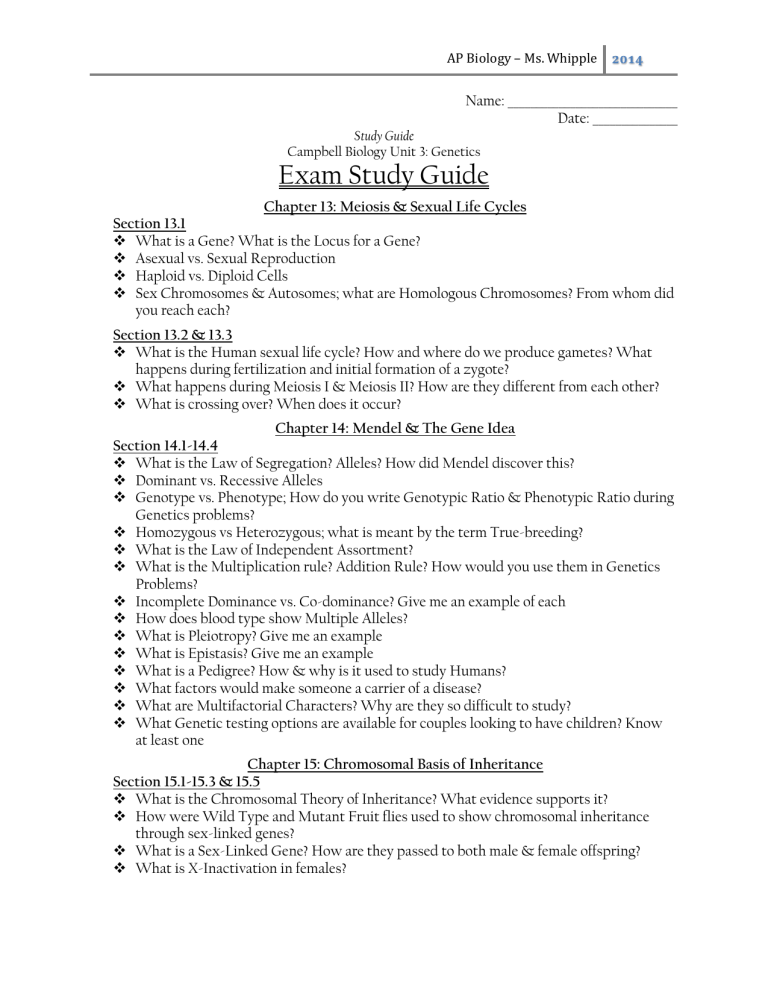
AP Biology – Ms. Whipple 2014
Name: ______________________________
Date: _______________
Study Guide
Campbell Biology Unit 3: Genetics
Exam Study Guide
Chapter 13: Meiosis & Sexual Life Cycles
Section 13.1
What is a Gene? What is the Locus for a Gene?
Asexual vs. Sexual Reproduction
Haploid vs. Diploid Cells
Sex Chromosomes & Autosomes; what are Homologous Chromosomes? From whom did you reach each?
Section 13.2 & 13.3
What is the Human sexual life cycle? How and where do we produce gametes? What happens during fertilization and initial formation of a zygote?
What happens during Meiosis I & Meiosis II? How are they different from each other?
What is crossing over? When does it occur?
Chapter 14: Mendel & The Gene Idea
Section 14.1-14.4
What is the Law of Segregation? Alleles? How did Mendel discover this?
Dominant vs. Recessive Alleles
Genotype vs. Phenotype; How do you write Genotypic Ratio & Phenotypic Ratio during
Genetics problems?
Homozygous vs Heterozygous; what is meant by the term True-breeding?
What is the Law of Independent Assortment?
What is the Multiplication rule? Addition Rule? How would you use them in Genetics
Problems?
Incomplete Dominance vs. Co-dominance? Give me an example of each
How does blood type show Multiple Alleles?
What is Pleiotropy? Give me an example
What is Epistasis? Give me an example
What is a Pedigree? How & why is it used to study Humans?
What factors would make someone a carrier of a disease?
What are Multifactorial Characters? Why are they so difficult to study?
What Genetic testing options are available for couples looking to have children? Know at least one
Chapter 15: Chromosomal Basis of Inheritance
Section 15.1-15.3 & 15.5
What is the Chromosomal Theory of Inheritance? What evidence supports it?
How were Wild Type and Mutant Fruit flies used to show chromosomal inheritance through sex-linked genes?
What is a Sex-Linked Gene? How are they passed to both male & female offspring?
What is X-Inactivation in females?
AP Biology – Ms. Whipple 2014
Review: How does Crossing Over and Independent Assortment guide the recombination of non-linked Genes?
What are Linked Genes? How is their inheritance different from non-linked genes?
How was a Genetic Linkage Map created from recombination rates of Linked Genes?
What are the map units? What are the limits to this?
What is Non-Disjunction? What are the results of this happening during gametogenesis?
How can a Chromosome be altered: Deletion; Duplication; Inversion; and Translocation.
What can result from any of these mutations occurring?
What causes Down syndrome?
Chapter 16: Molecular Basis of Inheritance
Section 16.1-16.2
How did scientists discover that DNA was the molecule of Inheritance? What did
Griffith and Hershey & Chase discover in their experiments?
How was the molecular structure of DNA discovered? How did Watson, Crick and
Franklin contribute to this discovery?
What is the molecular structure of DNA? Double Helix; Anti-Parallel, Base Pair
Matching. What are the Nucleotide base pairs and how do they bond?
What is the Semi-Conservative Model of DNA Replication? How did Meselson & Stahl provide evidence for this model?
What are Origins of Replication and the process of DNA Replication? Know the functions of each of the following enzymes: Helicase; Primase; DNA Polymerase; DNA
Ligase; Nuclease; Telomerase
Chapter 17: From Gene to Protein
Section 17.1-17.6
What is Gene Expression?
Describe the processes of Transcription in the Nucleus & Translation at the Ribosomes.
Development of one gene – one polypeptide theory.
What is the Template Strand? How is it read?
What is a Codon? Know how to translate an mRNA sequence using a decoder. How are amino acids bonded together to make polypeptide chains and then proteins?
What is a Reading Frame ? Why is this so important when it comes to sending messages?
Mutation: What is a mutation? Types of Mutations: Point Mutation; Nucleotide Pair
Substitution - Silent Mutation; Missense Mutation; Nonsense Mutation. Frameshift mutations: Insertions & Deletions.
Chapter 18: Regulation of Gene Expression
Section 18.2
Regulation of Eukaryotic Gene Expression: Epigenetics (Histone Acetylation & DNA methylation); DNA Control Elements & Enhancers; Alternate RNA splicing
Section 18.4
Differentiation of cells and Morphogenesis (giving rise to body shape)
Cytoplasmic Determinants in unfertilized egg regulating expression and cell type.
Induction of embryonic cells.
How to know Differentiation has occurred: Tissue Specific Proteins!
Pattern Formation and Positional Information for body shape.
AP Biology – Ms. Whipple 2014
Chapter 19: Viruses
Section 19.1-19.2
Discovery of Viruses – Tobacco Mosaic Virus
Structure of Viruses – Capsid; Genetic Material, maybe a Viral envelope
How does a Virus attack??
What is the Host Range of a Virus?
What is a Phage? (also called Bacteriophage)
Lytic Vs. Lysogenic Cycles
RetroViruses: What are they? How does HIV attack a person’s immune system?
Vaccines: How do they work?
Chapter 20: Biotechnology
Section 20.1-20.2
What is Genetic Engineering? How is it helpful for society?
What is recombinant DNA? How is it made? (Know each step and enzyme!!)
DNA Technology: Methods to know (especially know when and why you would use each!!) o Cloning a eukaryotic gene into a bacterial plasmid. How does this create the
Genomic Library?
o What is a BAC? How is it used?
o cDNA: What is it? How is it used?
o Nucleic Acid Hybridization using a nucleic acid probe.
o Polymerase Chain Reaction (PCR) o Gel Electrophoresis o Southern Blotting o Northern Blotting o DNA Microarray Assays o Genome Wide Studies and SNPs: how are they used as genetic markers?
Unit 3 Labs
Chi Square Analysis
Know how to use equation if given experimental data:
Comparing DNA Sequences
Review DNA Sequencing Lab and be prepared to analyze DNA fragments to create a cladogram.



